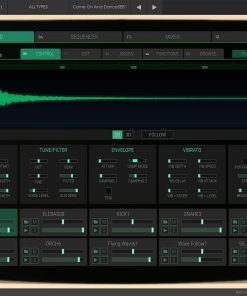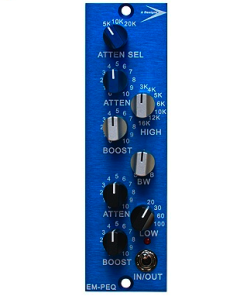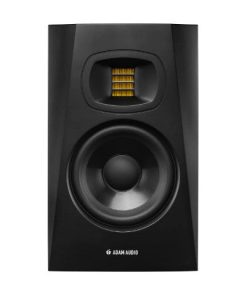Arturia CMI V License – Peerless Sampling Character Arturia
$ 149,00 $ 59,60
A spot-on reincarnation of the first commercially available digital sampling system in music history, the sonic powerhouse behind numerous early MTV-era megahits. We even added new creative features that weren’t possible back in the day.
A uniqueMusical Architecture
The first commercially available digital sampling system created the sound of countless MTV-era hits and evolved into a full music workstation.
We turbocharged it with state-of-the-art features to make it a centerpiece of your productions. The CMI’s signature 8-bit grunge on hits by Depeche Mode, Herbie Hancock, Peter Gabriel, Duran Duran, and Kate Bush – not to mention countless film scores – transports you straight to the ’80s. CMI V transports your creativity anywhere you want to take it.
Hear What They Heard
Once musicians experienced the dynamic power of the CMI, they were hooked – if they could afford one. CMI V puts it all in the palm of your hand.
Prime Specimen
CMI V begins by meticulously modeling a full-spec CMI Series IIx, which enthusiasts and seasoned producers consider the one to want.
Modern Superpowers
Much more than nostalgia, CMI V provides everything you need – and then some – to explore the intersection of sampling and digital synthesis for modern production.
The Sound of Digital
More precise than analog. More synth-sounding than software sample libraries. CMI V strikes the perfect balance for EDM, hip-hop, neo-disco, and anything in between.
The Sound ThatShook the World
As teenagers, Peter Vogel and Kim Ryrie loved electronic music. Their dream of making “the world’s greatest synthesizer” birthed an industry standard.
Both notorious pioneers, Vogel and Ryrie had built computers as school projects and were fans of “Switched On Bach” by Wendy Carlos. They saw combining the computer and the synthesizer as the future, and no one could have predicted just how much they would nail it. The pair got going in earnest in 1975, naming their company Fairlight after a harbor ferry in their home town of Sydney, Australia.
Vogel and Ryrie soon met Tony Furse, who had prototyped a digital synth based on dual Motorola 6800 CPUs. This led to the CMI’s predecessor, the Qasar M8. When the two recorded piano from a radio broadcast, then played it back at different pitches, the result sounded more like a real piano than any electronic attempt thus far. The friends came up with the term “sampling” to describe the process.
Main Features
- Software synthesizer playable through a MIDI keyboard
- 600 samples from the original CMI library
- 360 presets sounds made by Arturia sound designers
- Expanded number of track to 10 with a polyphony per track up to 32
- Perfect emulation of the analog filter response
- Faithful recreation of the sampling and additive synthesis capacities of the instrument
- Variable Bit Depth and Sample Rate
- Introduction of a new sound generation mode: Spectral synthesis
- Classic “page-R” inspired 32-step sequencer
- 24 sources of modulations per track to apply to all “CONTROL” parameters
- High-quality output effects
- VST, VST3, AU, AAX, and standalone operation
Platform specifications
Windows
- Win 8.1+ (64bit)
- 4 GB RAM
- 2.5 GHz CPU
- 2GB free hard disk space
- OpenGL 2.0 compatible GPU
Required configuration
- Works in Standalone, VST, AAX, Audio Unit, NKS (64-bit DAWs only).
Apple
- Mac OS 10.13+
- 4 GB RAM
- 2.5 GHz CPU
- 2GB free hard disk space
- OpenGL 2.0 compatible GPU
Protection
- The software is protected by the Arturia Software Center.
Prompt Delivery and Professional Packaging
Our long-standing partnership with UPS FedEx DHL and other global carriers lets us offer a range of shipping services. Our warehouse staff is extremely skilled and will package your items according to our precise and exact specifications. Your goods will undergo an extensive inspection and be safely packaged prior to being sent out. Each day, we ship to thousands of customers in many countries. The fact that we are committed to becoming the biggest online retailer in the World is clear. These warehouses are in Europe in the same way as they are in USA.
Note: Orders that include more than one item are assigned a processing period depending on the item.
Before shipping, we will inspect thoroughly the items you have ordered. Most orders are shipped within 48 hours. Expected delivery time is between 3-7 days.
Returns
Stock is dynamic. It's not entirely managed by us since we are involved with multiple entities, including the factory and the storage. The actual stock can change at any moment. It is possible that your order may be out of stock once the order has been placed.
Our policy lasts for 30 days. We cannot exchange or refund your order if it has been 30 days from the date of purchase.
For your item to be returned it must be in its original packaging, unopened and in the condition you received it. The item must be in its original packaging.
Related products
Recording Equipments
Microphones
Monitor Systems
Recording Equipments
Recording Equipments
Monitor
Subwoofer
Accessories
Microphones
Microphones
Monitor Systems
Recording Equipments
Accessories
Microphones
Monitor Systems
Monitor
Microphones
Monitor Systems
Recording Equipments
Headphones
Accessories
500 Series
500 Series
Monitor
Monitor
































































